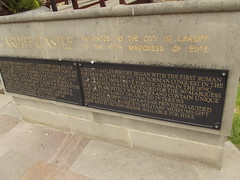Cardiff Castle
Commemorated on 1 plaque
Cardiff Castle presented to the City of Cardiff by the Fifth Marquess of Bute Cardiff Castle's history began with the first Roman fortress built in the 1st C,. The Norman conquest in the 11th C, brought impressive fortifications. In the 19th C, the apartments were extended for the 3rd Marquess of Bute by architect W.M. Burges and contain unique and spectacularly decorated interiors. The castle is open 362 days a year providing guided tours, medieval banquets, military museums, gift shops and function rooms available for hire
English translation: Cyflwynodd Gastell Caerdydd i Ddinas Caerdydd gan Bumed Ardalydd Bute hanes Castell Caerdydd yn dechrau gyda'r gaer Rufeinig cyntaf a adeiladwyd yn y C 1af,. Y goncwest Normanaidd yn y C 11eg, daeth amddiffynfeydd trawiadol. Yn y C 19eg, y fflatiau eu hymestyn ar gyfer 3ydd Ardalydd Bute gan WM pensaer Burges ac yn cynnwys tu unigryw ac wedi'u haddurno'n drawiadol. Mae'r castell ar agor 362 diwrnod y flwyddyn gan ddarparu teithiau tywys, gwleddoedd canoloesol, amgueddfeydd milwrol, siopau anrhegion a ystafelloedd digwyddiadau ar gael i'w llogi
Cardiff Castle - Duke Street, Cardiff, United Kingdom where it sited

